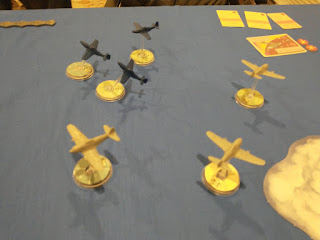 |
| The elusive Doug in his element |
We started with Doug and I getting an orientation game with Garret counseling us. 3 vs 3 planes (Germans vs Americans I believe). The rules are simple enough to make sense within two or three turns. The end of the mission typically comes from loss of nerve/confidence/morale rather than shooting down all the fighters. This is a good thing as lots of games of swoopy planes can DRAGGGGGG. Morale is lost everytime the enemy gets a good line on you and manages to fire on you. The shooting resolution is via fists full of dice and looking for fairly high numbers (I think successes are on a 6). The early war planes have much lower offensive dice pools so it's actually pretty hard to splash your opponent.
The bases are pretty clever with a tilt built into the stem. Nose up is advantage, level is neutral, and down is disadvantage. Pilot skill tells you who moves first, followed by (dis)advantage, and then finally actual airplane max speed. It rarely gets to that point.
As actions you can choose to gain advantage, maneuver (which tries to force your enemy within a certain range 'down' in advantage), or shoot. You can only shoot someone with less advantage than you. You can only take out a plane that is disadvantaged (I think otherwise it's forced lower still). So you end up with team work to hit the enemy by 'maneurvering' to lower it's advantage rating, and then a wingman to clean him up. I think this is the only mildly jarring aspect of the game to me: it makes sense for your high skill pilots to maneuver the enemy down, and then the lower skill (moving later) pilots to shoot them down. Who knows, maybe this is actually how it happens but it seems a bit odd. In terms of game mechanics though it works very very smoothly.
Next up we fought a three way melee. Japanese vs British vs Russians. Another nice touch is upon the start of the game you make a skill roll for each pilot which dictates what advantage level they start at. You will notice my green plans in the bottom right are all disadvantaged.....the Red airforce believe in training by doing!
We all elected to hold some planes as 'high cover'. I think this is scenario dependent, but basically they can show up on the board edge within a certain distance of marker on whatever turn. If they don't show up you can move the marker along the edge a certain distance. It's like aerial flankers!
Happily I brought in my high cover, who happened to be the highest skill planes, very early. And very very right behind the British. Garret knows the game; it's best to thin our his planes early.
Clouds are very interesting as when you enter them your advantage goes neutral immediately. So they are a safe harbor for planes in trouble, but neutralize your advantage if you are doing well.
Coming out of the cloud you have a choice to gain advantage, maneuver or shoot (like normal). This means that planes in advantage are pretty safe from things emerging from the clouds.
Firing ranges are fairly short, so despite playing on a 3x3 table with a lot of planes the opportunity for fire wasn't overwhelming (lots of planes aren't legal targets as they are at the same or higher advantage). By far maneuvering and gaining advantage are the most common actions taken.
Planes have some character to them, with differences in offense/defense and, more notably, special abilities. These abilities give you some cards you can play to do a bit extra. Lose advantage to move extra far. Similarly, the aces (rare as they are) come with a special ability which is much more powerful. One of them could use maneuver AND shoot in a turn. Nasty bit of work that could solo enemies on his/her own (Russians had female pilots anyway).
As the enemy gains numbers on you there is a bit of a snowball effect. But skill is quite important. Since you move and do actions it makes sense to move first, and the first movers can often make their opponents lose the advantage they need to take their shots.
Overall I was quite surprised by how much I enjoyed the game. While I don't know that I'd select it as a primary choice for a game night, it makes for quick games: so on a short night, or while killing time for the main event it seems like a great option.







A nice, comprehensive report Dave. Like you, I don't find aerial combat that stimulating, but I have played a few games of Wings of Glory (I think it's called) with a lovely collection of WWI aircraft, and it's fun for an hour or two every few months!
ReplyDeleteI've heard of wings of glory but I'm not sure that I've actually played it. I like to think that I haven't found 'the right game' for aerial combat....but maybe it's not for me. I'll have to try other systems first to decide!
DeleteBest review on this game that I've read to date. Sounds pretty simple for sure, but with nice little nuances to add depth without making for a 3+ hour grind.
ReplyDeleteThanks Dai! I can only assume there aren't many reviews then! =P
DeleteWell written review. Ended up reading the whole thing. I like the idea of aerial games and don’t even mind if they are really detailed but I usually find the tracking of altitude to be a wonky thing. It’s either a die or a dial or antenna like poles. I sometimes check out games at conventions. 😀
ReplyDeleteAltitude tracking is pretty annoying. I tried some check your six! and found that a good altitude tracking system is a serious barrier to enjoyable play for me.
Delete